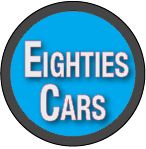I saw a white 1980 or 1981 Z28 with blue graphics (I believe the only way you can tell them apart is to get close enough to see the VIN’s length) out driving today, not once but twice. It wasn’t quite in show condition, but it still looked pretty sharp, and you so rarely see these cars on the road in 2014. We’ll go with the 1980 version for this post because it had slightly more horsepower.
“The Maximum Camaro.”
For 1980, the aging second-generation Chevrolet Camaro (the title of Car and Driver‘s road test for the 1980 Z28 was a cruel “A medieval warrior on the path to a rocking chair“) received some updates, including exterior styling changes and a more powerful engine for the Z28. Not much could be done about the general lack of space efficiency (the EPA rated all Camaros as subcompact cars), the relatively high weight, and the fairly primitive technology.
The standard (and only) Z28 powertrain for states other than California was the LM1 5.7 liter/350 ci V8 with a four-barrel Rochester carburetor and 8.2:1 compression matched with a four-speed manual transmission. At 190 bhp, this engine had the most horsepower seen in any Camaro since 1974 (sigh). For 1980, Chevrolet engineers added a solenoid-driven air intake to the back of the redesigned hood scoop.
Car and Driver managed to get the 3,660 pound Z28 from 0-60 in 8.5 seconds with a 120 mph top speed. Fuel mileage was predictably bad—14 city/21 highway by the day’s standards. With a 20.9-gallon gas tank, a Z28 owner could expect a range of about 330 miles with a 10% fuel reserve.
The Z28‘s base price was $7,121; about $26,600 in today’s dollars and just about what a base 2022 Camaro 1LS goes for. Standard exterior and mechanical equipment included heavy-duty shocks and springs, body color Sport mirrors, a front air dam, a rear spoiler, and P225/70R15 white-lettered radial tires (a size still readily available) on body-colored 15-inch wheels. Inside, power steering, full gages, center console, cut-pile carpeting, and vinyl bucket seats were standard.
Options & Production Numbers
External options included 15 x 7-inch cast aluminum wheels ($184), tinted glass ($68), and removable glass roof panels ($695). Inside, you could add air conditioning ($566), an intermittent windshield wiper system ($41), an electric rear window defogger ($107), automatic speed control ($112), power door locks ($93), power windows ($143), a Comfortilt steering wheel ($81), and nine different radios including an AM/FM stereo radio with a stereo cassette player ($272).
Z28 sales were good in 1980, though they did not match 1979’s numbers. Chevrolet sold 45,137 Z28s in the 1980 model year, making them almost 30% of total Camaro production.

The View From 2022

Long neglected by the collector market and with most now used up, late second-generation Z28s in good or great shape now get interesting numbers at auctions. A largely stock Black 1980 Z28 went for $45,000 at Mecum’s January 2022 auction in Kissimmee. According to Hagerty’s valuation tools, all the money for a 1980 Z28 in #1/Concours condition is $47,600. A more normal #3/Good condition version is valued at $21,000.
Make mine Red, I think. Surprisingly—at least to me—the most popular Camaro color in 1980 was Dark Blue.
Other Camaros I have covered include the 1980 Rally Sport coupe, the 1984 Sport Coupe, the 1985 Berlinetta hatchback coupe, and the 1985 IROC-Z hatchback coupe. Why am I concentrating so much on the 1980 and 1985 Camaros?
Updated March 2022.
